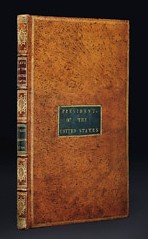
PREV ARTICLE
NEXT ARTICLE
FULL ISSUE
PREV FULL ISSUE
WAYNE'S NUMISMATIC DIARY: OCTOBER 14, 2012The Writer's Almanac for October 9th stated: In 1888 on this day, the Washington Monument was opened to the public. In 1848, at a Fourth of July ceremony, the cornerstone of the monument was laid. Lack of funds and continued interruptions delayed completion until its completion and dedication on February 21, 1885. The 555-foot structure opened officially to the public on October 9, 1888. By the day of the grand opening, the monument was outfitted with a steam-powered elevator that took 10 or 12 minutes for the trip up and down. At the time, it was the tallest building in the world. In the first nine months, more than 600,000 people visited, and by the turn of the century, more than 1.5 million had come. I passed this factoid on to Eric Schena, who adds: Another fun fact: at the time of completion, the aluminum "topper" was the single largest piece of cast aluminum. As it happened, October 9th was the meeting of my monthly numismatic social group, Nummis Nova, and by happenstance we were meeting at The Mount Vernon Inn at George Washington's estate near Alexandria, VA. Eric and I made plans to play hooky from our respective jobs to get there a little early and visit the museum. Steve Bishop also joined us - he was already waiting when I arrived. I poked around the gift shop while we waited for Eric. I purchased two sets of replica currency - the quality seemed very high and the price a bargain. I plan to donate them as auction lots for the next local coin show kid's event, although truth be told, I wouldn't mind keeping them for myself. One packet is a group of 10 continental Current notes, and the other has thirteen state notes, one from each original colony, a tough set to complete for real. When Eric arrived we made our way to the ticket window. As it happened, going late afternoon midweek in October is a fine way to avoid crowds - there were only four people ahead of us, and the whole place looked deserted. We got a timeslot for the very end of the day, and would be able to visit the mansion as well as the museum if we hurried. So we rushed to the visitor center/museum first. I don't know if Steve ditched us or we ditched him, but we got separated in the visitor center. Eric and I walked thru the museum together. Right in the main entrance stands Houdin's iconic bust of Washington on a pedestal, behind glass. It was a delight to finally view this work in person. I have on my desk at home a reproduction modeled after Houdin's bust, which the Washington family felt was his most accurate likeness.
Around a nearby corner Eric pointed out his favorite sign - it read, "Please Do Not Photograph the General's Dentures". I noted several of the numismatic items on display:
Some of the non-numismatic items I found interesting were:
One item that is sometimes seen in auctions of colonial numismatic items is a gorget. On display was a c. 1776 gorget of Alexander Hume with the motto & emblem of the 2nd South Carolina regiment. "Gorget" is such an obsolete term that my spell checker doesn't even know it. I've seen definitions such as "a piece of armor for the throat" or "a crescent-shaped ornament". Can anyone more familiar with colonial garb tell us more about gorgets and any numismatic connections? We raced out of the museum to get to the mansion for our tour, taking some pictures along the way. Once inside we caught up with Steve Bishop. It was an enjoyable and quick tour, with few other tourists ahead of us. Here are Eric's thoughts on our visit. He writes: I am really glad we could at least tour a little bit - wish I had gotten there sooner. The artifacts in the galleries were great: I particularly enjoyed seeing included the Indian Peace medal with the necklace - I have only seen photos or reproductions of them and I have never seen one with the necklace. To see an original in person, albeit with glass in between me and the artifact, was particularly meaningful. Another item I really liked seeing in person was the c. 1831-1832 French made Order of the Cincinnati badge in gold. Of all the society badges in the US, I have always thought the Cincinnati badge was the most beautiful, but I have again only seen later versions. One thing I particularly liked about going when we did was being able to photograph the house with no one standing in front - with such a huge landmark, opportunities like that are few and far between. And to think that I lived within 10 minutes of there for many years at one point and never saw any of that... I made a stop at my car to pick up the magnifier I'd forgotten. In the parking lot I ran into Dave Schenkman and we walked together to the restaurant. Gene Brandenburg was waiting out front. When we walked in it was easy to tell Gene and Dave had been here before. Elsie, one of the waitresses, gave Gene a hug. They were quite the odd couple, looking like Archie Bunker and Louise Jefferson dancing cheek-to-cheek. Gene told everyone, "she's my ex-wife!" She gave Dave a hug next, and he said, "she's MY ex-wife, too!" We made our way over to our usual table. Other attendees were Brian Cushing, Jon Radel, Mike Packard, Julian Leidman and Tom Kays. Ron Abler and Joe Levine each had to cancel for personal reasons. Gene wasted no time in ordering his favorite menu item, the Hoe Cakes.
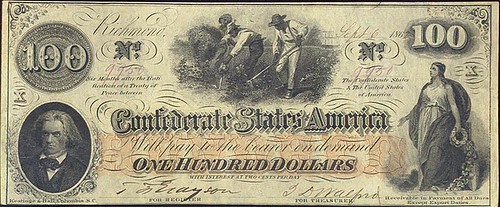
Dave Schenkman had several recent purchases as well, and he sent in images of a couple of them, both Bolen tokens. The Pioneer Base Ball Club token is the earliest known baseball token. The second piece, appropriately, has a Washington portrait on the obverse.
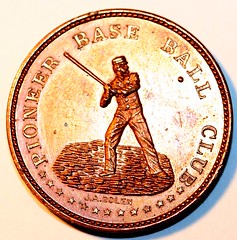

Pioneer Base Ball Club, Springfield, MA

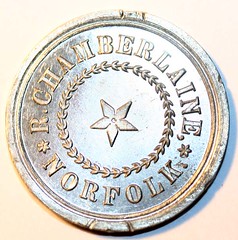
Dave writes: The Virginia token is white metal (tin, as Merriam called it) and is a mule with a Bolen die. Only five struck, per Musante. The Pioneer Baseball Club piece is Bolen’s first work, as I recall. 75 struck in copper and 125 in white metal. Eric Schena wrote up this description of an item he exhibited, a stock certificate with a connection to Washington (see below image): I brought it since the New Shenandoah Co. was a successor to the Patowmack Company, which George Washington served as its first president. The New Shenandoah Company was established by the Virginia General Assembly in 1814 to take over making navigation of the Shenandoah River possible from the Patowmack Company. The company built and maintained navigable channels and dams for flat bottomed boats called gundalows starting at Port Republic in Rockingham Co., VA, with a major stop at Front Royal/Riverton and ending at Harper’s Ferry in Jefferson Co., then in VA. Gundalows were used for only one trip down the river where, after reaching their destination (usually either Front Royal/Riverton or Harper’s Ferry), the boats were broken up and sold for lumber. In 1814, the New Shenandoah Company was granted the right to raise $100,000 by selling shares of stock at $50 per share (with 300 shares being reserved for the Patowmack Company as payment for construction already built/undertaken), however, the few seen examples of the stock certificates all bear the date November 16, 1824 in groups of 5 shares per certificate. The handwritten notation at right edge (in same hand as S.H. Lewis, company secretary/treasurer) reads: "$50 per share. Transferable by deed on the books of the N S Co." This one was issued to Capt. Isaac Bowman (1757-1826), operator of a flour & grist mill along Cedar Creek just east of Strasburg on the Shenandoah/Warren County line. Originally built in 1792-1793, the mill was in ruins by the 1920s and finally demolished sometime in the 1970s. The mill race now forms part of the main course for Cedar Creek.
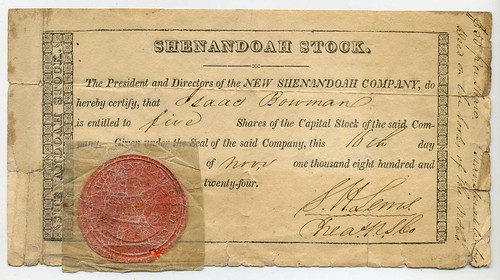
I wish I could show some images of the museum items, but no photography was allowed. I'd written to the curators asking if we could speak with someone, but I didn't hear back until today. I asked about getting some images, so maybe we’ll have some next week. It was another great evening of numismatic fellowship. These dinners are the highlight of everyone's month, and being able to visit the Mount Vernon museum and mansion made it a really special occasion for me. We broke up around 9:30 or so and I pointed my car toward home. 'Til next month! To read the complete Writer's Almanac on the web, see: The Writer's Almanac: TUESDAY Oct. 9, 2012 (www.elabs7.com/functions/message_view.html?mid=1593730&mlid=499&siteid=20130&uid=0ce7fb4f1a) To read the earlier E-Sylum article on Washington's Acts of Congress, see: NOTES FROM E-SYLUM READERS: APRIL 29, 2012: George Washington's Acts of Congress (www.coinbooks.org/esylum_v15n18a16.html)
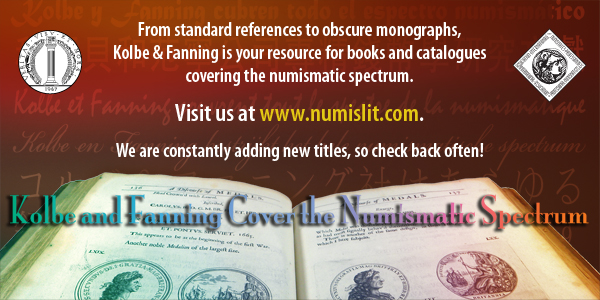
Wayne Homren, Editor The Numismatic Bibliomania Society is a non-profit organization promoting numismatic literature. See our web site at coinbooks.org. To submit items for publication in The E-Sylum, write to the Editor at this address: whomren@gmail.com To subscribe go to: https://my.binhost.com/lists/listinfo/esylum All Rights Reserved. NBS Home Page Contact the NBS webmaster 
|
